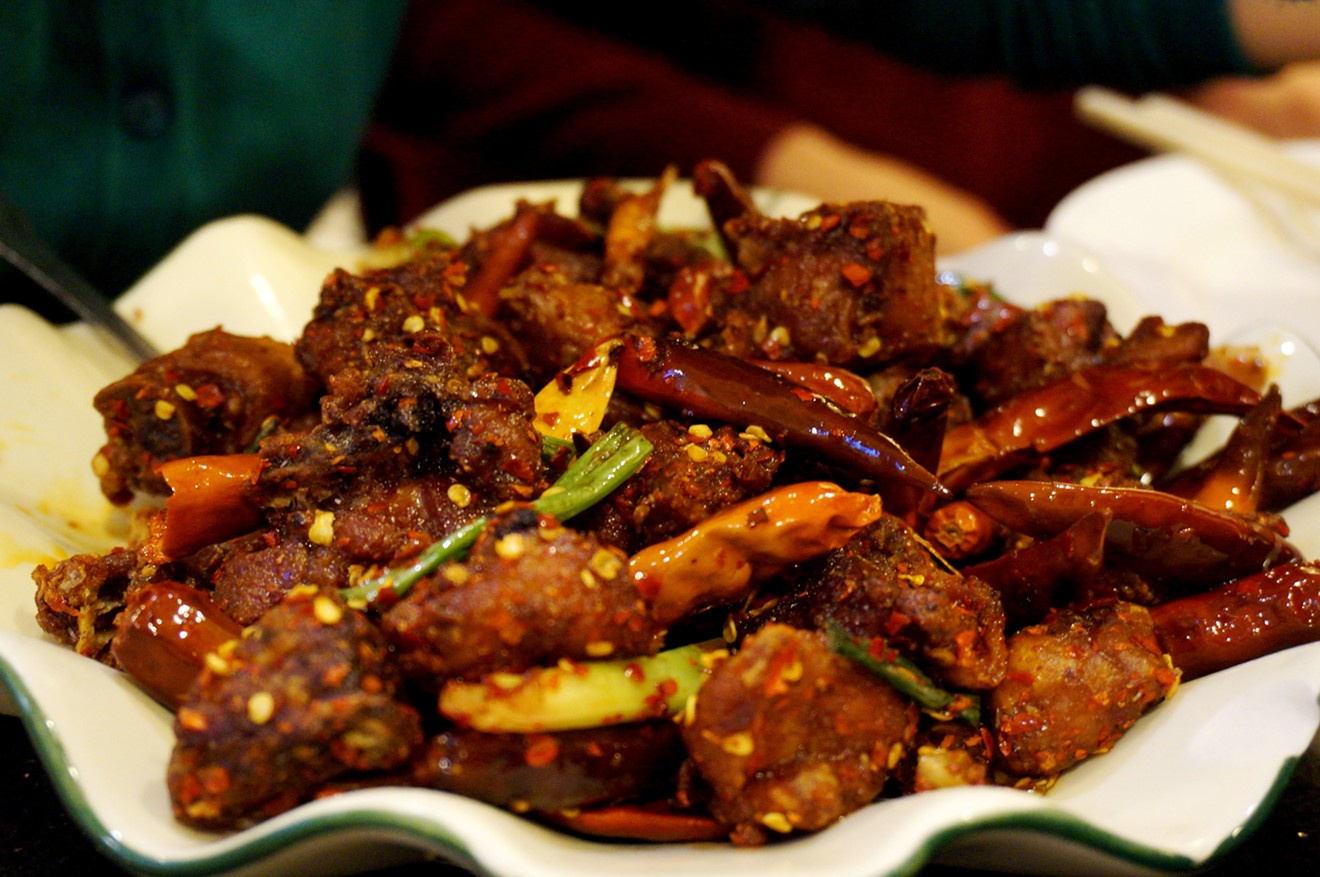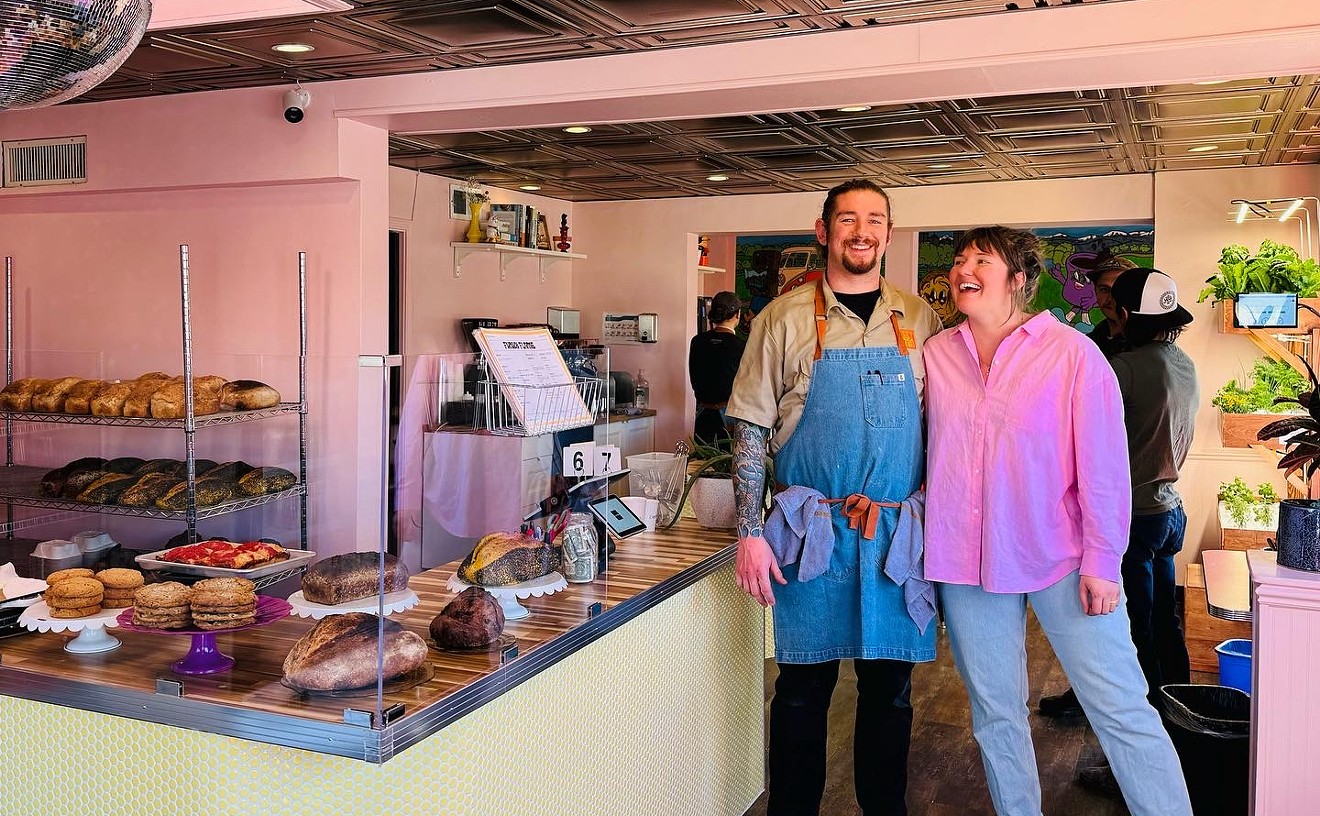A few months back, fresh from my return from Beijing to the States, I explored Denver for Chinese food like the kind I’d eaten across the Pacific, coming up with a short list of places that offer tastes of iconic dishes. It was mostly limited to Taiwanese and Cantonese food, with a dash of bullfrog hot pot, something I’d consumed frequently in Beijing on a street that was famous for it. And I thought that was likely to be the extent of what I’d find here, since most Chinese immigrants who own restaurants are Cantonese or Taiwanese.
But then Uncle and Hop Alley proprietor Tommy Lee pointed me to Little Chengdu, a Tech Center strip-mall joint that still bears the English name of its predecessor, Blue Ocean, on its signage. Go at night, he advised, because that’s when the owner is most likely to be there, hand-pulling noodles. I was also interested in the restaurant’s promise of Sichuan-style hot pot; my excitement grew as I scanned photos of vats of broth colored an angry red and dotted with dozens of chiles.
Little Chengdu’s owners actually hail from Jilin province, which sits to the north of the North Korean border, but they’re cooking a broad menu culled from all over the Middle Kingdom. Many of the dishes, like la zi ji ding (or hot and spicy chicken), are hits from Sichuan, but there are also Lanzhou-style noodles and dapanji (big tray chicken), a poultry stew that comes from the northwestern province of Xinjiang. (Legend has it that dapanji was invented by a Sichuan migrant.)
To access those dishes, though, you’ll need to ask for the Chinese menu, a long list that has been helpfully translated into English; the first menu you’ll be handed when you sit down deals in classic American-Chinese fare and platters that dabble liberally in the pan-Asian pantry. You’ll also get the hot pot menu, an all-you-can-eat proposition that rings in at $25.99 per person.
While it’s tempting to do as my group did and order both hot pot and other dishes, it’s more prudent (and wallet-friendly) to stick to one or the other. And they’re both excellent propositions. Hot pots come loaded with chili and Sichuan peppercorns (and it’s worth being firm about your high spice tolerance if you want the electric tingle of the latter), and you can choose from a broad array of items to cook. Personal favorites include tofu skin, shrimp balls, enoki mushrooms and shaved beef, plus a few greens to throw in at the end (beware, though — greens soak up broth more completely than the other hot pot ingredients, so they’re significantly spicier when you pull them out). Create a personal dipping sauce from the condiment bar while you wait for your pot to bubble; I like a combination of sesame paste and sesame oil plus crushed garlic and scallions.
What’s going to bring me back to Little Chengdu, though, are the noodles, which are, indeed, hand-pulled to order in the middle of the restaurant. The owner makes noodles of several varieties and widths, plunking them into soups and sautéing them with fiery chili oil. Lanzhou-style beef noodle soup swims with thin, chewy strands, the broth thick and heavy, long-simmered with beef and punchy with garlic. What’s billed on the menu as hot and spicy white and green noodles are not green at all, but rather long, wide and flat strips lazing in pools of chili oil cut by an edge of tart vinegar, topped with sautéed cabbage and thin sheets of beef. Eaters who’ve had Shaanxi-style noodles at a place like New York City’s Xi’an Famous Foods will recognize a kindred spirit in this dish. And then there are the knife-shaved noodles, haphazard chunks stripped from pasta dough and plunked into soup whose broth approximates a homey chicken noodle, albeit with a nutty hint that adds unusual nuance.
Next time I go, I’ll also try the liang pi, a cold noodle dish popular all over China, and the hot-and-sour flat rice noodle soup, which looked like an approximation of the fiery beef noodle soups popular at Sichuan stalls.
Whatever you do, don’t miss the wonton soup in hot chili oil, which is not a soup at all, but rather chao shou — hand-wrapped, pork-stuffed Sichuan dumplings pooled with Sichuan peppercorn-spiked chili oil. In fact, get those whether you go the hot pot route or the noodle route. They're a good addition either way.
[
{
"name": "Air - MediumRectangle - Inline Content - Mobile Display Size",
"component": "12017618",
"insertPoint": "2",
"requiredCountToDisplay": "2"
},{
"name": "Editor Picks",
"component": "17242653",
"insertPoint": "4",
"requiredCountToDisplay": "1"
},{
"name": "Inline Links",
"component": "18838239",
"insertPoint": "8th",
"startingPoint": 8,
"requiredCountToDisplay": "7",
"maxInsertions": 25
},{
"name": "Air - MediumRectangle - Combo - Inline Content",
"component": "17261320",
"insertPoint": "8th",
"startingPoint": 8,
"requiredCountToDisplay": "7",
"maxInsertions": 25
},{
"name": "Inline Links",
"component": "18838239",
"insertPoint": "8th",
"startingPoint": 12,
"requiredCountToDisplay": "11",
"maxInsertions": 25
},{
"name": "Air - Leaderboard Tower - Combo - Inline Content",
"component": "17261321",
"insertPoint": "8th",
"startingPoint": 12,
"requiredCountToDisplay": "11",
"maxInsertions": 25
}
]
















